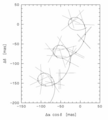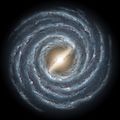Hipparcos facts for kids
Hipparcos was a special satellite launched by the European Space Agency (ESA). Its main job was to measure the exact positions of stars in space. It created a huge list, called the Hipparcos Catalogue, which included 118,000 stars. This list was incredibly accurate, much more precise than anything before it!
The satellite was launched in 1989 and worked until 1993. It was named after an ancient Greek astronomer called Hipparchus. The name Hipparcos is also a clever acronym, standing for HIgh Precision PARallax COllecting Satellite.
Contents
What Hipparcos Did
Hipparcos was like a super-accurate mapmaker for the stars. Before Hipparcos, astronomers could only guess the distances to many stars. This satellite changed everything.
Measuring Star Distances
Hipparcos used a method called parallax to measure how far away stars are. Imagine holding your finger out in front of your face and closing one eye, then the other. Your finger seems to jump! This is parallax.
- As Earth travels around the Sun, our view of nearby stars changes slightly.
- Hipparcos measured these tiny shifts in star positions over time.
- The bigger the shift, the closer the star is to us.
- This allowed scientists to create a 3D map of stars in our part of the Milky Way galaxy.
Why Accuracy Matters
Knowing the exact positions and distances of stars is super important for astronomy.
- It helps us understand how big stars really are.
- It helps us figure out how bright they truly shine.
- It helps us learn how stars move through space.
- This information is vital for understanding our galaxy and the universe.
How Hipparcos Worked
The Hipparcos satellite had special tools to do its job. It continuously scanned the sky, looking at stars from different angles.
Scanning the Sky
The satellite had two telescopes that looked at two different parts of the sky at the same time. These views were combined.
- It spun slowly, sweeping across the sky like a lighthouse beam.
- As stars passed through its view, their positions were recorded very precisely.
- Over its four years of operation, Hipparcos collected millions of measurements.
The Hipparcos Catalogue
All the data collected by Hipparcos was used to create the famous Hipparcos Catalogue.
- This catalogue lists the positions, distances, and movements of 118,000 stars.
- It also created a less precise list, called the Tycho Catalogue, with over a million stars.
- These catalogues are still used by astronomers today.
Legacy of Hipparcos
Even though Hipparcos stopped working in 1993, its work continues to be very important.
- It greatly improved our understanding of the stars closest to our Sun.
- The data helped scientists learn more about the size and structure of our galaxy.
- It paved the way for future missions, like the Gaia satellite, which is even more powerful.
Hipparcos was a true pioneer in space astronomy, showing us just how much we can learn about the universe from above Earth's atmosphere.
Images for kids
See also
 In Spanish: Hipparcos para niños
In Spanish: Hipparcos para niños




